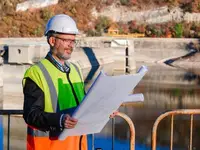Now that you’ve established contact with the EPA, and assembled the team, it’s crucial to begin developing a response plan. This plan will serve as your roadmap to address the violations identified and ensure future compliance with the Clean Water Act.
Developing a Clean Water Act response plan begins with a thorough review of the violations outlined in the EPA notification. This step is essential to gain a clear understanding of what needs to be addressed and how to prioritize your actions. By identifying the root causes of the violations, you can develop targeted strategies to rectify them.
Once you have a comprehensive understanding of the violations, it’s time to outline the specific steps you will take to address each issue. This may involve:
- Site Investigation
- Project Definition/Charter
- Capital Planning
- Consent Decree Compliance
- Regulatory Compliance & Review
- Design Definition & Delivery
- Construction Monitoring & Compliance Strategies
In addition to outlining specific actions, your Clean Water Act response plan should also include a timeline for completion. This will help you stay organized and ensure that progress is being made. Regularly reviewing and updating the plan will also allow you to make any necessary adjustments along the way.
Public Communication
It is a balancing act of how, when and where to inform residents about these types of issues that may impact their overall environment and health. When a municipality faces a violation related to water management or environmental safety, transparency becomes crucial. Informing the public about the nature of the violation, its potential impacts on local water bodies, and the specific measures being undertaken to rectify the issue is not just a matter of responsibility but also a means of fostering community trust.
With the guidance of the right team the municipality’s approach can involve using various communication channels such as:
- local news
- social media
- community meetings
- official websites
Louisiana municipalities must present information in a way that is understandable to the general public and avoid overly technical language. Regular updates are also vital to keep the community informed about the progress being made in addressing the issue.
Maintaining transparency throughout the process of addressing the environmental issue helps preserve public trust. Additionally, by owning the story, the municipality can mitigate the spread of misinformation and prevent public panic or distrust. Open communication will foster a collaborative relationship with the community, where residents feel included and empowered to contribute to environmental conservation efforts. This approach not only addresses the immediate issue but also fosters a culture of environmental responsibility and community involvement.
Ensuring Future Compliance
It’s imperative to establish a robust framework for continuous improvement and monitoring when creating a Clean Water Act response plan.. Learning from past violations is a critical step in this process. This involves a thorough analysis of the causes of these violations and the implementation of strategic measures to prevent their recurrence.
Regular water sampling and testing are essential components of this strategy. By frequently monitoring the quality of water sources, municipalities identify potential issues early on, allowing for timely interventions. Establishing a rigorous testing schedule with strict adherence ensures that any deviations from established water quality standards are quickly addressed.
Implementing best management practices (BMPs) is another key aspect. BMPs are proven techniques or methods that, when applied, help to manage pollutants and protect water quality. This includes practices related to stormwater management, wastewater treatment, and erosion control, among others. Adopting these practices demonstrates a commitment to environmental stewardship and regulatory compliance.
Train staff on proper procedures, especially in handling hazardous materials, is crucial. Employees should be well-versed in the protocols that prevent pollutants from entering waterways. This training should be ongoing, reflecting any changes in regulations or operational practices. Engaging staff in regular training sessions not only enhances their skills but also reinforces the importance of compliance and environmental protection.
Maintaining open lines of communication with the EPA is vital. Regular updates on progress and challenges helps build a cooperative relationship. This transparency creates a valuable feedback loop and allows for guidance from the EPA, aiding in effective remediation efforts. Additionally, consulting with the EPA on future compliance initiatives helps in aligning municipal strategies with federal standards and expectations.
Conclusion
Navigating the aftermath of a Clean Water Act violation is a complex but manageable task. It requires a blend of immediate action, strategic long-term planning, and a commitment to transparent communication with the public. By taking these steps, a municipality not only addresses the immediate compliance requirements but also reinforces its commitment to preserving Louisiana’s waterways and wetlands now and in the future.

